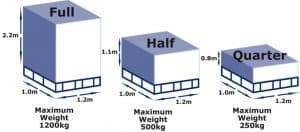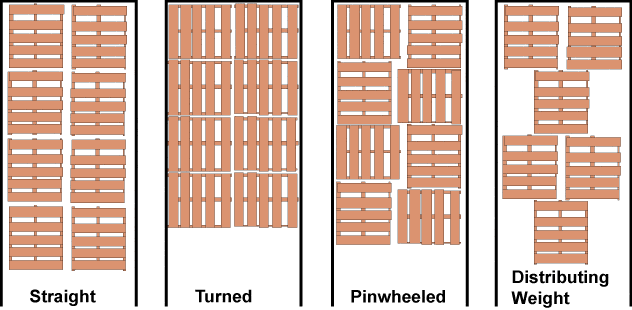Ultimate Guide to Understanding Cubic Feet
Freight Density Calculator
Awarded #1 in Shipping
click on badge
Pallet Calculator
How many skids in a 53' trailer?
The freight LTL business and the understanding footage for flatbed trucks, reefer and dry vans trailer cube utilization is entirely about density.
When discussing 53 foot trailer cubic feet or 53′ trailer cbm. To determine how many pallets in 53′ trailer or the volume of a 53 foot trailer holds.
The 53-foot trailer cube calculator equation is, 3816 cubic feet of air (8’ wide by 9′ high by 53′ long).
e well-equipped to navigate the complexities of global shipping.
International Shipping Services
How many standard pallets fit on a 53 foot trailer?
When understanding 53-foot trailer dimensions and weight. Calculations show a 53-foot trailer (636” long) can hold 13 pallets lengthwise, with an extra 1 foot.
These wide trailers fit two rows of pallets. So loaded into every 53-foot trailer, the answer is is 26 pallets.
If we loaded air, 3816 cf would be a full load.
But we load a wide variety of shapes and sizes, some square, some rectangular, some round, with many pieces irregular in shape which create air pockets, no matter how well the trailer is loaded.
So we accept 64 cu. ft. (8’ x 8′) for each lineal foot of trailer as being the practical maximum loading.
Therefore, a load with 3400 cubic feet is about as perfect as anyone can get.
The economics are based on the following expectations:
48 foot trailer: 3000 cu. ft. or 30,000 lbs 53 foot trailer: 3400 cu. ft. or 34,000 lbs.
This explains the “conversion factor” of 10 lbs. per cubic foot.
This is called density and is very important in determining freight rates or charges when understanding cubic feet with pallets.
Most office furniture moves on cube rates, so the density is not a big issue. However, some products are heavy with a little cube, so weight (density) is a factor, and we will charge on weight. Then there is flatbed trucks and warehousing to consider.
At Paige Logistics, we treat each lineal foot of the trailer deck (floor) as equivalent to 64 cu. ft. (8′ x 8′ x 1’ = 64 cu. ft.) or 640 lbs.
This works out to 3392 cu. ft. for a trailer.
Sometimes skids are so irregular and awkward that nothing can be loaded on top, so the tariff has a rule for that.
When factories load head-loads, they cannot be touched, so rates are based on lineal feet used, and converted to weight or cube, as noted above.
This clear analysis of the pallet cubic feet calculator will determine success or failure when understanding cubic feet specifically in the logistics service business.
How to Calculate Pallet Cube
Cheat Code of Understanding Cubic Feet
The cubic feet pallet calculator is to multiply length 48″ x width 40″ x height 28″ (22″ plus 6″ of pallet) = 53,760 cubic inches.
Divide 53,760 by 1,728 = 31.1cubic feet.
Divide 110 pounds (80 lbs for the carton and approximately 30 lbs for the pallet) by 31.1 cubic feet = 3.54 pounds per cubic feet (PCF), i.e., density.
the Grocery Manufacturers Association (GMA) pallet is the most popular, used to transport a substantial chunk of the U.S.’s palletized shipment.
These food-industry-compliant pallets measure 48 inches long by 40 inches wide and devote a considerable amount of time in dry vans.
Whether your pallets are 48 inches long and 40 inches wide and your dry van is 53 feet (636 inches) long and 100 inches wide, users should be able to load 26 pallets “straight” throughout the floor of a dry van.
The calculation is as follows:
First Step: 636 inches (dry van length) / 48 inches (GMA pallet length) = 13.25 pallets
Step 2: Since the interior width of most dry vans is 100 inches, two 40-inch pallets can fit side by side across their decks. Therefore, 13.25 x 2 = 26.5 GMA pallets total on a 53-foot dry van.
Suppose you wish to load a few additional GMA pallets onto a 53-foot dry van.
This is reasonable, given that maximizing your shipping dollars is crucial to the success of your business and shipping extra pallets LTL is insufficient.
How does pinwheeling work?
First Step: 100 inches (width of dry van) minus 48 inches (straight-loaded pallet) = 52 inches remaining.
52 inches remaining minus 40 inches (straight loaded pallet = 12 inches remaining) (plenty of room for securement)
Step 3: Load each pallet in a pinwheel pattern, alternating the 40-inch and 48-inch sides. This will leave you with seven pallets in each direction (a total of fourteen) per row, requiring a total of 616 inches. By strategically “pinwheeling” 28 pallets, you will be able to load them onto a 53-foot dry van trailer.
Here’s how “turning” pallets works, assuming the dry van used is 102 inches wide:
Step 1: 636 inches (the length of the dry van) divided by 40 inches (the width of a GMA pallet) equals 15.9 pallets
Step 2: Two 48-inch-wide pallets can fit side-by-side across the deck of a dry van trailer. Therefore, 15 x 2 = 30 total GMA pallets can be loaded sideways on a 53-foot dry van.
GMA pallets represent only a portion of all pallets used in the United States. Countless pallets are designed to meet the specifications of the products they transport.
The cubic feet of a pallet 48 x 40 x 48 = 92160
Following the 48×40 GMA pallet are the following common pallet sizes:
- 42 inches across and 42 inches in length (42X42)
- 36 inches across and 36 inches in length (36X36)
- 48 inch width x 48 inch length (48X48)
- 48 inches across by 45 inches in length (48X45)
dry-van-trailer-loaded-with-pallets
How To Calculate Freight Class?
To calculate cubic feet, start with determining the dimensions of a single pallet in your shipment.
Eg: assume that you are shipping boxes that are sized at 3 ft x 4 ft x 5 ft.
Weigh the pallet. Assume that it weighs 260 lbs.
Calculate the pallet volume by multiplying the dimensions by each other.
For this case, 3 * 4 * 5 = 60 cu ft.
To calculate the density, divide the weight by the cargo volume: 260/60 = 4.33 lb/cu ft.
Compare this value with the table above to find the appropriate freight class.
In this case, your shipment belongs to freight class 200.
Dry van trailers are the most common type of equipment in the transportation industry.
From household goods and hospitality products to a variety of food and drink items, these trailers are extraordinarily versatile.
If you have a product that can be loaded from the rear and fits within the dimensions of a dry van, there is no better way to transport it. Simple and direct.
Numerous times per day, palletized goods are transported in dry van trailers. And, when done properly, transporting boxed food in a dry van can be very cost-effective.
However, getting the most out of your transportation budget is frequently a matter of planning, and you do not know how many pallets you can fit in a van trailer.
This makes it nearly impossible to schedule the number of trucks you’ll need and budget accordingly.
At Paige Logistics, as a freight forwarder shipping from Canada to the USA, we manage drayage and warehousing and have been transporting with dry van & reefer for decades. As a result, our understanding of worldwide shipping logistics services and this trucking capacity topic is exhaustive, and we’re eager to share it with you.
Understanding how many pallets in a 53 foot trailer in a dry van trailer is crucial to your supply chain and the success of your business be it serving heavy haul trucking for construction logistics .
If your cargo density is just below the upper limit of the current freight class (for example, 7.98 lb/cu ft), adding just a small amount of weight from the pallet will bring higher class results and, subsequently, in lower freight rates.

It is possible to have the opportunity to pay less in the end!
In addition, if the density is almost equal to the upper limit of the freight class, you could try reducing the volume by a few cubic inches by compacting your shipment a little more will bring in a more economic freight class.
You can also check out the CBM calculator to calculate the total volume of your cargo.
Did you know Paige Logistics excels in worldwide shipping? We the Canadian leader in sea freight forwarding to service importers shipping from China to Canada. We have complete drayage services available. Learn about shipping incoterms and get into detail with DAP delivered at place services.
Now that you have the freight, take a closer look at it to optimize it. Read further for cost saving tips!
Need to match the right truck? Learn about flatbed weight limit truckload trailer types.
Looking for a better trucking company that saves money on LCL or LTL freight shipping logistics from Canada to USA?
The number of pallets that can fit on a 53-foot trailer can vary depending on several factors, including the size of the pallets and how they are loaded onto the trailer. However, as a rough estimate, you can typically fit around 26 standard-sized pallets in a single layer on a 53-foot trailer. If you utilize double stacking, you may be able to fit around 52 pallets. These numbers can vary based on pallet size, weight distribution, and other factors, so it’s always a good idea to consult with a logistics expert for precise calculations based on your specific situation.
31.1 cubic feet
31.1 cubic feet. To calculate the cubic feet in a 53-foot trailer, you need to know the dimensions of the trailer. A standard 53-foot trailer typically has dimensions of approximately 53 feet in length, 8 feet 6 inches in width, and 9 feet in height.To find the cubic feet, you multiply the length by the width by the height: 53 feet (length) × 8.5 feet (width) × 9 feet (height) = 4,807.5 cubic feet. So, a standard 53-foot trailer has approximately 4,807.5 cubic feet of space. Keep in mind that the actual usable space might be slightly less due to the shape of the trailer and any obstructions such as wheel wells or equipment.
26. The total number of pallets which can fit in a dry van tends to vary depending on the size of the pallets.
Indeed, there is.Consider “pinwheeling” or “turning” your goods to fit more 48×40 pallets as opposed to loading them straight. View example in image above.
“Pinwheeling” allows for the placement of 28 GMA pallets across the floor of a van trailer, while “turning” allows for the placement of 30.
The cubic feet of a pallet can vary depending on its dimensions and design. A standard pallet size in the United States is typically 48 inches by 40 inches. If we assume a standard height of around 6 inches for the pallet, we can calculate the cubic feet:
48 inches (length) × 40 inches (width) × 6 inches (height) = 11,520 cubic inches
To convert cubic inches to cubic feet, we divide by 1728 (since there are 1728 cubic inches in a cubic foot):
11,520 cubic inches ÷ 1728 = 6.67 cubic feet
So, a standard pallet with dimensions of 48 inches by 40 inches by 6 inches has approximately 6.67 cubic feet of space. Keep in mind that actual pallet dimensions may vary, so it’s always a good idea to measure the specific pallet you’re working with for accurate calculations.
To find the cubic yards in a 53-foot trailer, you first need to calculate the cubic feet, as we did earlier. We found that a 53-foot trailer typically has approximately 4,807.5 cubic feet of space.
To convert cubic feet to cubic yards, you divide by 27 (since there are 27 cubic feet in a cubic yard):
4,807.5 cubic feet ÷ 27 = 178.06 cubic yards (approximately)
So, a standard 53-foot trailer has approximately 178.06 cubic yards of space. This can vary slightly depending on the exact dimensions of the trailer and any obstructions inside, but this calculation provides a good estimate.

Author, Founder & Chief Executive Officer of Paige Logistics Ltd. → Experienced operations leader with a demonstrated history of working in the Freight Shipping, Trucking and the Railroad Industry.
Stuck for finding the best freight forwarder China to Canada? Shipping with Paige Logistics! Offering extended cross border shipping Canada to California.
2023 Global Leader In Shipping
Freight Carriers Association of a Canada
Related Posts

Freight Brokerage Unlocking the Potential of Freight Brokerage Solutions for Your Business Click For Best Price Awarded #1 in Shipping click on badge Deliveries +

Freight & Shipping Insurance The Comprehensive Guide to Shipping Insurance for Freight in International Trade Click For Best Price Awarded #1 in Shipping click on

Understanding Specialized Transport Click For Best Price From Giant Machines to Hazardous Materials: The Wild Side of Specialized Transportation! Awarded #1 in Shipping click on

Seasonal Load Restrictions How to Outsmart Seasonal Load Limits and Save Big! Click For Best Price Awarded #1 in Shipping click on badge + 0

Mastering the Intricacies of CFR Incoterms A Comprehensive Guide Click for Best price CLICK ON BADGE Deliveries + 0 Happy Clients 0 manufacturers 0 Awards

CIF Incoterms The Comprehensive Guide to CIF (Cost, Insurance & Freight) in International Trade Click For Best Price Awarded #1 in Shipping click on badge
Check out Our Customer Reviews


